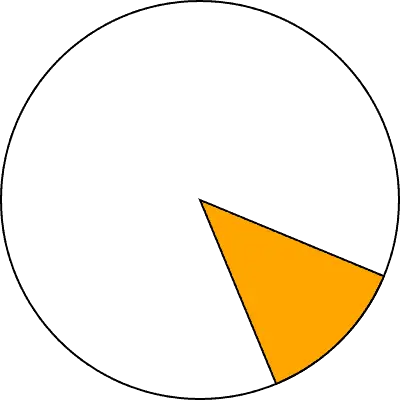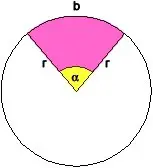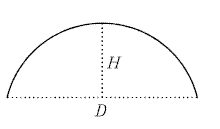In geometry, you will sometimes see parts of circles (such as semicircles, quarter circles, or other portions). It helps to know how to find the perimeter and area of these shapes.
So, what do you need to know about the perimeter & area of circular sectors? A circular sector has a perimeter that is a fraction of the circle’s circumference plus twice the radius. A circular sector has an area that is a fraction of the circle’s area. The fraction is the number of degrees in the sector divided by 360 – for a sector with D degrees, the fraction is D/360.
Of course, we can come up with formulas for special cases, such as semicircles or quarter circles.
In this article, we’ll talk about how to find the perimeter and area of circular sectors. We’ll also look at some examples to make the concepts clear.
Let’s get started.
Perimeter & Area Of A Circular Sector
To find the perimeter or area of a circular sector, we should first understand what this shape is.
A circular sector has a boundary of two radii of the circle, and the arc that connects the two endpoints of the radii that lie on the circle. As you can see in the image below, there are two arcs: the shorter one bounds the minor sector (the curved edge of the orange piece), and the larger one bounds the major sector (the curved edge of the white piece).

Before we can find the perimeter and area of a circular sector, we need to know the values for the entire circle. For a circle with radius R, the perimeter is given by:
- Perimeter Of Circle = 2πR [has linear units, and is also known as the circumference]
And the area is given by:
- Area Of Circle = πR2 [has square units]
Now we can figure out how to find the perimeter and area of circular sectors.
Perimeter Of A Circular Sector
For a circular sector, the perimeter has two parts:
- The first part is a fraction of the circle’s perimeter.
- The second part is twice the circle’s radius.

If the circular sector has a central angle of D degrees, then the fraction of the perimeter is given by D/360. If the angle D is given in radians, then the fraction of the perimeter is given by D/2π.
So, the first part of the perimeter of a circular sector looks like this:
- (D/360)*(Perimeter Of Circle) [if D is in degrees]
- (D/2π)*(Perimeter Of Circle) [if D is in radians]
We know that the perimeter (or circumference) of the circle is 2πR, so we can substitute to get:
- (D/360)*(2πR) [if D is in degrees]
- (D/2π)*(2πR) [if D is in radians]
Simplifying these formulas, we get:
- (DπR /180) [if D is in degrees]
- DR [if D is in radians]
Now, all we have to do is add twice the radius, or 2R (to account for the second part of the perimeter). This gives us:
- Perimeter Of Circular Sector = (DπR /180) + 2R [if D is in degrees]
- Perimeter Of Circular Sector = DR + 2R [if D is in radians]
We can apply this formula to special cases, such as semicircles or quarter circles.
Formula For Perimeter Of A Semicircle
For a semicircle, we know that the central angle is D = 180 degrees (or D = π radians). Substituting this value into our perimeter formula, we get:
- Perimeter Of Semicircle = (180πR /180) + 2R
- Perimeter Of Semicircle = πR + 2R
Simplifying, we get:
- Perimeter Of Semicircle = πR + 2R
- Perimeter Of Semicircle = πR + 2R
Both of the formulas match up (as they should), and we can factor to get (π + 2)R as the perimeter of a semicircle.
So for a semicircle with a radius of 5, we would get a perimeter of (π + 2)5 or 5π + 10.

Formula For Perimeter Of A Quarter Circle
For a quarter circle, we know that the central angle is D = 90 degrees (or D = π/2 radians). Substituting this value into our perimeter formula, we get:
- Perimeter Of Quarter Circle = (90πR /180) + 2R
- Perimeter Of Quarter Circle = (π/2)R + 2R
Simplifying, we get:
- Perimeter Of Quarter Circle = (πR/2) + 2R
- Perimeter Of Quarter Circle = (πR/2) + 2R
Both of the formulas match up (as they should), and we can factor to get ((π + 4)/2)R as the perimeter of a quarter circle.
So for a quarter circle with a radius of 6, we would get a perimeter of ((π + 4)/2)6 or 3π + 12.

We can also find the perimeter of circular sectors with other angles as well.
Example 1: Perimeter Of A Circular Sector
Let’s say we have a circular sector with a central angle of 120 degrees and a radius of R = 9. We know that the central angle is D = 120 degrees (or D = 2π/3 radians). Substituting these angle values into our perimeter formula, we get:
- Perimeter Of Circular Sector = (120πR /180) + 2R
- Perimeter Of Circular Sector = (2π/3)R + 2R
Simplifying, we get:
- Perimeter Of Circular Sector = (2πR/3) + 2R
- Perimeter Of Circular Sector = (2πR/3) + 2R
Both of the formulas match up (as they should), and we can factor to get ((2π + 6)/3)R as the perimeter of this circular sector.
So for a circular sector with central angle 120 degrees and with a radius of 9, we would get a perimeter of ((2π + 6)/3)9 or 6π + 18.
Example 2: Perimeter Of A Circular Sector
Let’s say we have a circular sector with a central angle of 150 degrees and a radius of R = 24. We know that the central angle is D = 150 degrees (or D = 5π/6 radians). Substituting these angle values into our perimeter formula, we get:
- Perimeter Of Circular Sector = (150πR /180) + 2R
- Perimeter Of Circular Sector = (5π/6)R + 2R
Simplifying, we get:
- Perimeter Of Circular Sector = (5πR/6) + 2R
- Perimeter Of Circular Sector = (5πR/6) + 2R
Both of the formulas match up (as they should), and we can factor to get ((5π + 12)/6)R as the perimeter of this circular sector.
So for a circular sector with central angle 150 degrees and with a radius of 24, we would get a perimeter of ((5π + 12)/6)24 or 20π + 48.
Area Of A Circular Sector
For a circular sector, the area has one part: it is a fraction of the circle’s area.

If the circular sector has a central angle of D degrees, then the fraction of the area is given by D/360. If the angle D is given in radians, then the fraction of the area is given by D/2π.
So, the area of a circular sector looks like this:
- (D/360)*(Area Of Circle) [if D is in degrees]
- (D/2π)*(Area Of Circle) [if D is in radians]
We know that the area of the circle is πR2, so we can substitute to get:
- (D/360)*(πR2) [if D is in degrees]
- (D/2π)*(πR2) [if D is in radians]
Simplifying these formulas, we get:
- DπR2 /360 [if D is in degrees]
- DR2/2 [if D is in radians]
We can apply this formula to special cases, such as semicircles or quarter circles.
Formula For Area Of A Semicircle
For a semicircle, we know that the central angle is D = 180 degrees (or D = π radians). Substituting this value into our area formula, we get:
- Area Of Semicircle = 180πR2 /360
- Area Of Semicircle = πR2/2
Simplifying, we get:
- Area Of Semicircle = πR2/2
- Area Of Semicircle = πR2/2
Both of the formulas match up (as they should), so the perimeter of a semicircle with radius R is πR2/2.
So for a semicircle with a radius of 8, we would get an area of π(8)2/2 or 32π.
Formula For Area Of A Quarter Circle
For a quarter circle, we know that the central angle is D = 90 degrees (or D = π/2 radians). Substituting this value into our area formula, we get:
- Area Of Quarter Circle = 90πR2 /360
- Area Of Quarter Circle = (π/2)R2/2
Simplifying, we get:
- Area Of Semicircle = πR2/4
- Area Of Semicircle = πR2/4
Both of the formulas match up (as they should), so the perimeter of a semicircle with radius R is πR2/4.
So for a semicircle with a radius of 10, we would get an area of π(10)2/2 or 50π.
We can also find the perimeter of circular sectors with other angles as well.
Example 1: Area Of A Circular Sector
Let’s say we have a circular sector with a central angle of 135 degrees and a radius of R = 4. We know that the central angle is D = 135 degrees (or D = 3π/4 radians). Substituting these angle values into our area formula, we get:
- Area Of Circular Sector = 135πR2 /360 [if D is in degrees]
- Area Of Circular Sector = (3π/4)R2/2 [if D is in radians]
Simplifying, we get:
- Area Of Circular Sector = (3πR2/8)
- Area Of Circular Sector = (3πR2/8)
Both of the formulas match up (as they should), so the area of this circular sector is (3πR2/8).
So for a circular sector with central angle 135 degrees and with a radius of 4, we would get an area of 3π(4)2/8 = 6π.
Example 1: Area Of A Circular Sector
Let’s say we have a circular sector with a central angle of 210 degrees and a radius of R = 12. We know that the central angle is D = 210 degrees (or D = 7π/6 radians). Substituting these angle values into our area formula, we get:
- Area Of Circular Sector = 210πR2 /360 [if D is in degrees]
- Area Of Circular Sector = (7π/6)R2/2 [if D is in radians]
Simplifying, we get:
- Area Of Circular Sector = (7πR2/12)
- Area Of Circular Sector = (7πR2/12)
Both of the formulas match up (as they should), so the area of this circular sector is (7πR2/12).
So for a circular sector with central angle 210 degrees and with a radius of 12, we would get an area of 7π(12)2/12 = 84π.
Conclusion
Now you know how to find the perimeter and area of a circular sector. Remember to convert to the proper units (degrees or radians) depending on the context of the problem.
You can learn about ways to find the area of a square here.
You can learn about ways to find the perimeter of a square here.
I hope you found this article helpful. If so, please share it with someone who can use the information.
Don’t forget to subscribe to my YouTube channel & get updates on new math videos!
~Jonathon


